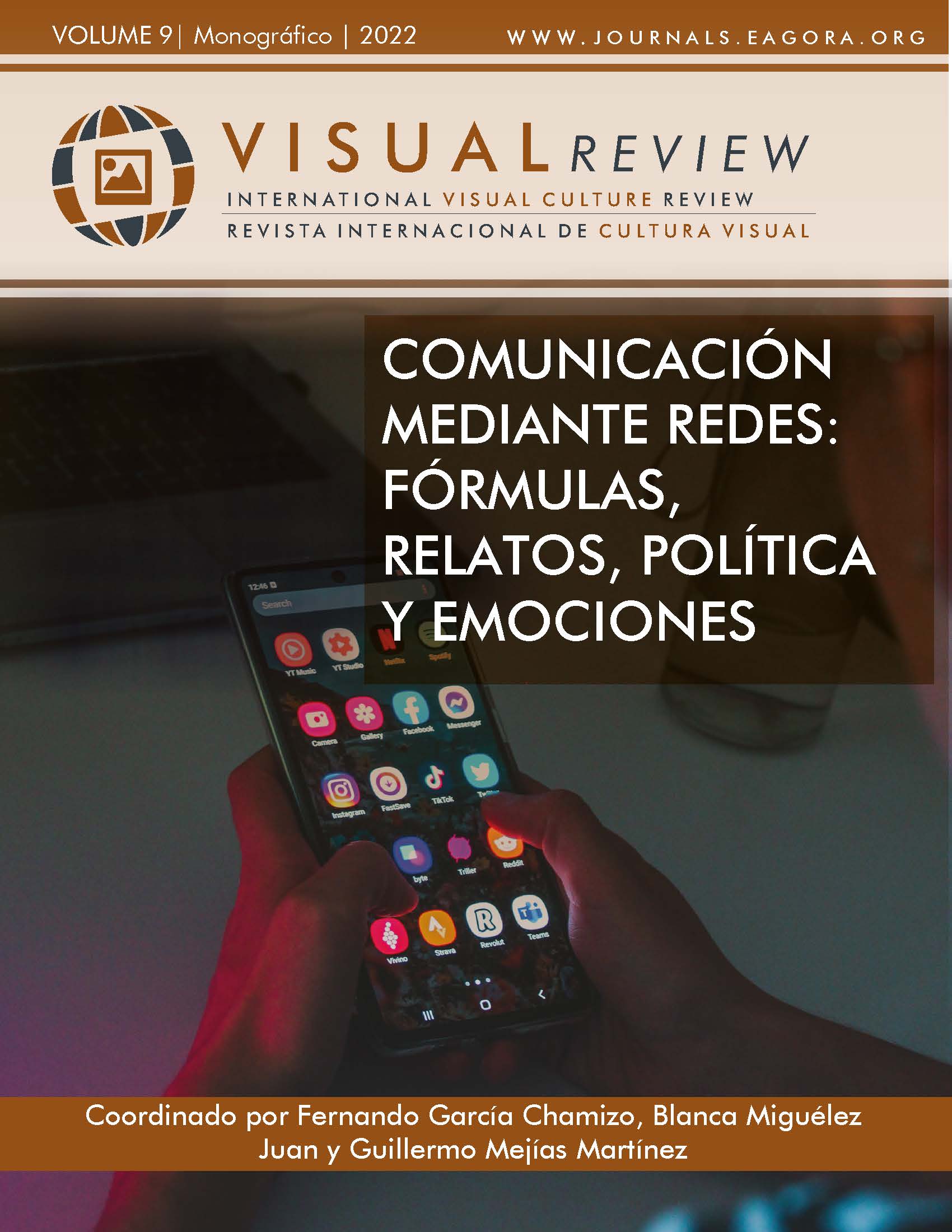Engaging the public in science crowdfunding
Scientists calling to action through visual and verbal strategies
DOI:
https://doi.org/10.37467/revvisual.v9.3534Keywords:
Science crowdfunding, Digital communication, Engagement, Persuasion, Rhetoric, MultimodalityAbstract
Crowdfunding is a collaborative funding strategy increasingly used by scientists to finance their research projects. It involves raising small donations from the online public, which challenges scientists to create engaging crowdfunding proposals in digital platforms. These proposals become more persuasive with a short video promoting the project and arguing why it deserves funding. By adopting a multimodal approach, this paper explores the visual and verbal engagement strategies used in those videos, to observe how scientists exploit different semiotic resources to reach out to the public and call them to action.
Downloads
References
Boesen, A. (2019). Effects of lead exposure in Scandinavian brown bears. Norway: Experiment.com. Retrieved from https://experiment.com/projects/effects-of-lead-exposure-in-scandinavian-brown-bears
Daly, P., & Davy, D. (2016). Structural, Linguistic and Rhetorical Features of the Entrepreneurial Pitch: Lessons from the Dragon’s Den. The Journal of Management Development, 35(1), 120-132. https://doi.org/10.1108/JMD-05-2014-0049 DOI: https://doi.org/10.1108/JMD-05-2014-0049
Díez-Prados, M. (2019). Verbal and nonverbal engagement devices in business persuasive discourse. The elevator pitch. In C. Sancho- Guinda (Ed.). Engagement in professional genres (pp. 217-242). John Benjamins. DOI: https://doi.org/10.1075/pbns.301.12die
Duscher, A., & Vroom, M. (2018). Squid in Space: Symbiosis and Innate Immunity. Florida: Experiment.com. Retrieved from https://experiment.com/projects/squid-in-space-symbiosis-and-innate-immunity
Experiment (2022). Researcher Guide. Design an Experiment. Retrieved June 2022 from https://experiment.com/guide
Franzoni, C., & Sauermann, H. (2014). Crowd science: The organization of scientific research in open collaborative projects. Research policy, 43(1), 1-20. DOI: https://doi.org/10.1016/j.respol.2013.07.005
https://www.sciencedirect.com/science/article/pii/S0048733313001212
Friese, S. (2017). ATLAS. ti 8 Windows Quick Tour. Berlin: Atlas. ti scientific software development. http://downloads.atlasti.com/docs/quicktour/QuickTour_a8_win_es.pdf
Gerber, L., & Hui, J. (2016). Crowdfunding: how and why people participate. In International perspectives on crowdfunding. Emerald Group Publishing Limited. DOI: https://doi.org/10.1108/978-1-78560-315-020151003
Harwood, N. (2005). We do not seem to have a theory. The theory I present here attempts to fill this gap: Inclusive and exclusive pronouns in academic writing. Applied Linguistics, 26(4), 343-373. https://academic.oup.com/applij/article/26/3/343/181373?login=true DOI: https://doi.org/10.1093/applin/ami012
Hyland, K. (2001). Bringing in the reader: Addressee features in academic articles. Written Communication, 18(4), 549-574. DOI: https://doi.org/10.1177/0741088301018004005
https://journals.sagepub.com/doi/10.1177/0741088301018004005
Hyland, K. (2002). Directives: Argument and engagement in academic writing. Applied Linguistics, 23(2), 215-239. https://academic.oup.com/applij/article/23/2/215/153874 DOI: https://doi.org/10.1093/applin/23.2.215
Hyland, K. (2004). Engagement and disciplinarity: The other side of evaluation. In G. Del Lungo- Camiciotti, and E. Tognini- Bonelli (Eds.). Academic discourse: New insights into evaluation (pp. 13-30). Bern: Peter Lang.
Hyland, K. (2005). Stance and engagement: a model of interaction in academic discourse. Discourse Studies, 7(2), 173-192. https://doi.org/10.1177/1461445605050365 DOI: https://doi.org/10.1177/1461445605050365
Jewitt, C., Bezemer, J., & O’Halloran, K. (2016). Introducing multimodality. Routledge. DOI: https://doi.org/10.4324/9781315638027
Jiang, F., & Ma, X. (2018). ‘As we can see’: Reader engagement in PhD candidature confirmation reports. Journal of English for Academic Purposes, 35, 1-15. https://www.sciencedirect.com/science/article/pii/S1475158518301954 DOI: https://doi.org/10.1016/j.jeap.2018.05.003
Kress, G., & van Leeuwen, T. (2006). Reading images. The grammar of visual design. (2nd ed.). London: Routledge. DOI: https://doi.org/10.4324/9780203619728
Lafuente-Millán, E. (2014). Reader engagement across cultures, languages and contexts of publication in business research articles. International Journal of Applied Linguistics, 24(2), 201-223. https://onlinelibrary.wiley.com/doi/10.1111/ijal.12019 DOI: https://doi.org/10.1111/ijal.12019
Luzón, M. J. & Pérez-Llantada, C. (2019). (Eds.). Science Communication on the Internet. Old genres meet new genres. Amsterdam: John Benjamins. DOI: https://doi.org/10.1075/pbns.308
Luzón, M. J. (2019). Bridging the gap between experts and publics: The role of multimodality in disseminating research in online videos. Ibérica, 37, 167-192. https://zaguan.unizar.es/record/86410/files/texto_completo.pdf
McInnes, J. (2018). Population Ecology of Risso’s Dolphins in Monterey Bay, California. California: Experiment.com. Retrieved from https://experiment.com/projects/population-ecology-of-risso-s-dolphins-in-monterey-bay-california
McLaren-Hankin, Y. (2019). Rebuilding trust in the banking sector: Engaging with readers in corporate press releases. In C. Sancho- Guinda (Ed.). Engagement in professional genres (pp. 87-100). John Benjamins. DOI: https://doi.org/10.1075/pbns.301.05mcl
Mehlenbacher, A. R. (2017). Crowdfunding Science: Exigencies and Strategies in an Emerging Genre of Science Communication. Technical Communication Quarterly, 26(2), 1-18. https://www.tandfonline.com/doi/pdf/10.1080/10572252.2017.1287361 DOI: https://doi.org/10.1080/10572252.2017.1287361
Mehlenbacher, A. R. (2019). Science Communication Online: Engaging Experts and Publics on the Internet. Columbus: The Ohio State University Press. DOI: https://doi.org/10.26818/9780814213988
Pullman, G. (2013). Persuasion. History, Theory, Practice. Indianapolis: Hackett Publishing Co.
Shu, D. & Das, S. (2017). How do cataracts form and how can they be prevented? Sidney: Experiment.com. Retrieved from https://experiment.com/projects/how-do-cataracts-form
Ruiz-Madrid, N., & Valeiras-Jurado, J. (2020). Developing multimodal communicative competence in emerging academic and professional genres. International Journal of English Studies, 20(1), 27-50. https://revistas.um.es/ijes/article/download/401481/285021 DOI: https://doi.org/10.6018/ijes.401481
Vachelard J., Gambarra-Soares, T., Augustini, G., Riul, P., & Maracaja-Coutinho, V. (2016). A Guide to Scientific Crowdfunding. PLoS Biol 14(2), e1002373. https://journals.plos.org/plosbiology/article?id=10.1371/journal.pbio.1002373 DOI: https://doi.org/10.1371/journal.pbio.1002373
Valeiras-Jurado, J. (2021). Multimodal persuasive strategies in product pitches. Text & Talk, 41(4), 561-584. https://www.degruyter.com/document/doi/10.1515/text-2019-0254/html DOI: https://doi.org/10.1515/text-2019-0254
Wheat, R. E., Wang, Y., Byrnes, J. E., & Ranganathan, J. (2013). Raising money for scientific research through crowdfunding. Trends in ecology & evolution, 28(2), 71-72. https://www.sciencedirect.com/science/article/pii/S0169534712002984 DOI: https://doi.org/10.1016/j.tree.2012.11.001
Xia, S. A., & Hafner, C. A. (2021). Engaging the online audience in the digital era: A multimodal analysis of engagement strategies in TED talk videos. Ibérica, 42, 33-58. http://revistaiberica.org/index.php/iberica/article/download/598/188 DOI: https://doi.org/10.17398/2340-2784.42.33
Downloads
Published
How to Cite
Issue
Section
License
Those authors who publish in this journal accept the following terms:
- Authors will keep the moral right of the work and they will transfer the commercial rights.









